Sociology Assignment: Race, Ethnicity, and Meritocracy in Singapore
VerifiedAdded on 2023/06/05
|9
|1984
|473
Essay
AI Summary
This sociology essay examines the concepts of race, ethnicity, and multiracialism, focusing on their application and management in Singapore. The essay begins by defining race and ethnicity, contrasting them with nationalism, and highlighting their impact on individual positions within society. It then delves into Singapore's approach to multiculturalism, as promoted by Prime Minister Lee Hsien Loong, emphasizing the country's efforts to maintain communal harmony despite racial and cultural differences. The essay further analyzes Singapore's specific brand of multiracialism, its historical context as a plural society, and how it contrasts with other models of handling diverse societies. It explores multiracialism as a 'top-down' nation-building strategy and examines the role of meritocracy in the context of social stratification, concluding with a discussion of Singapore's diverse leadership and the importance of merit-based systems. The essay uses references to support its arguments and provide a comprehensive understanding of the subject.
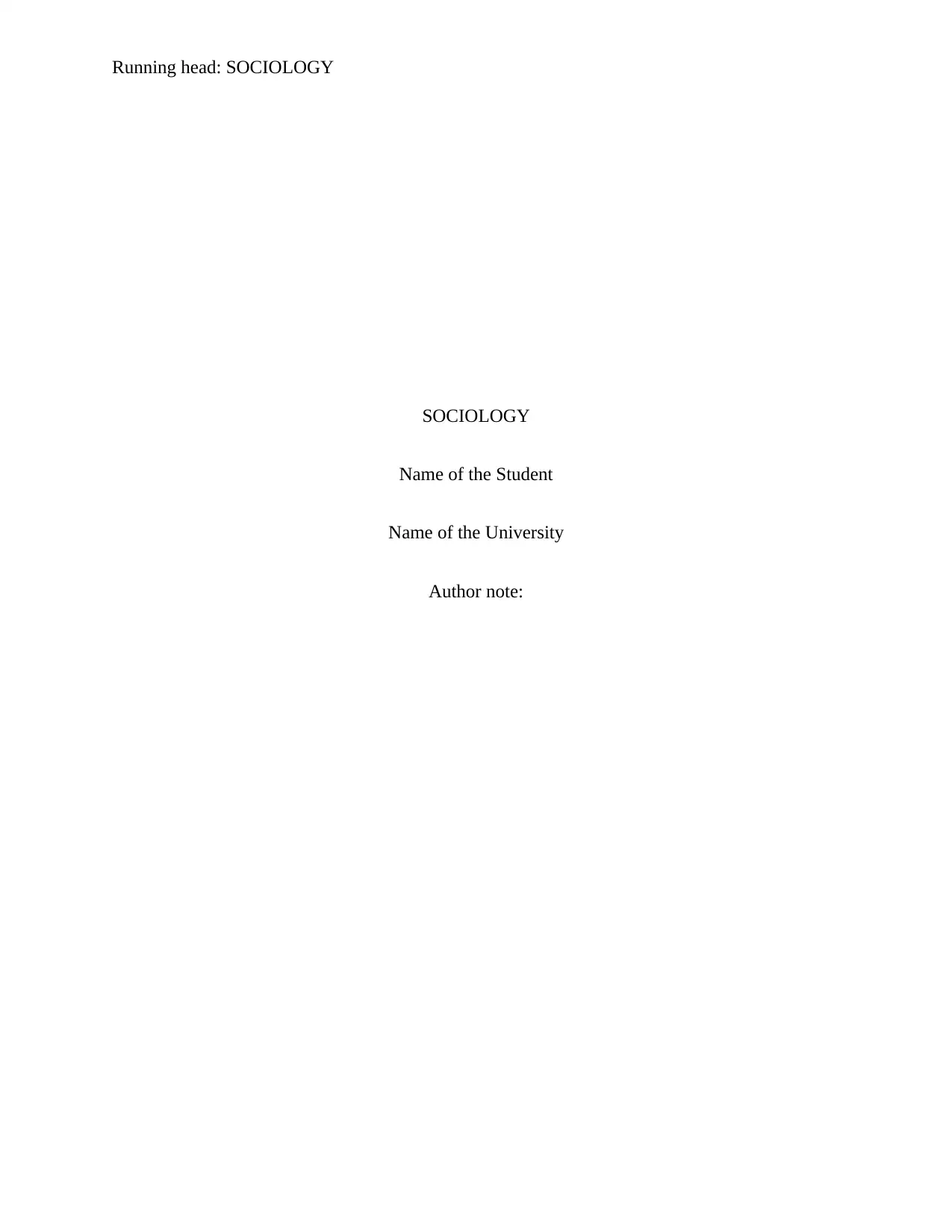
Running head: SOCIOLOGY
SOCIOLOGY
Name of the Student
Name of the University
Author note:
SOCIOLOGY
Name of the Student
Name of the University
Author note:
Paraphrase This Document
Need a fresh take? Get an instant paraphrase of this document with our AI Paraphraser
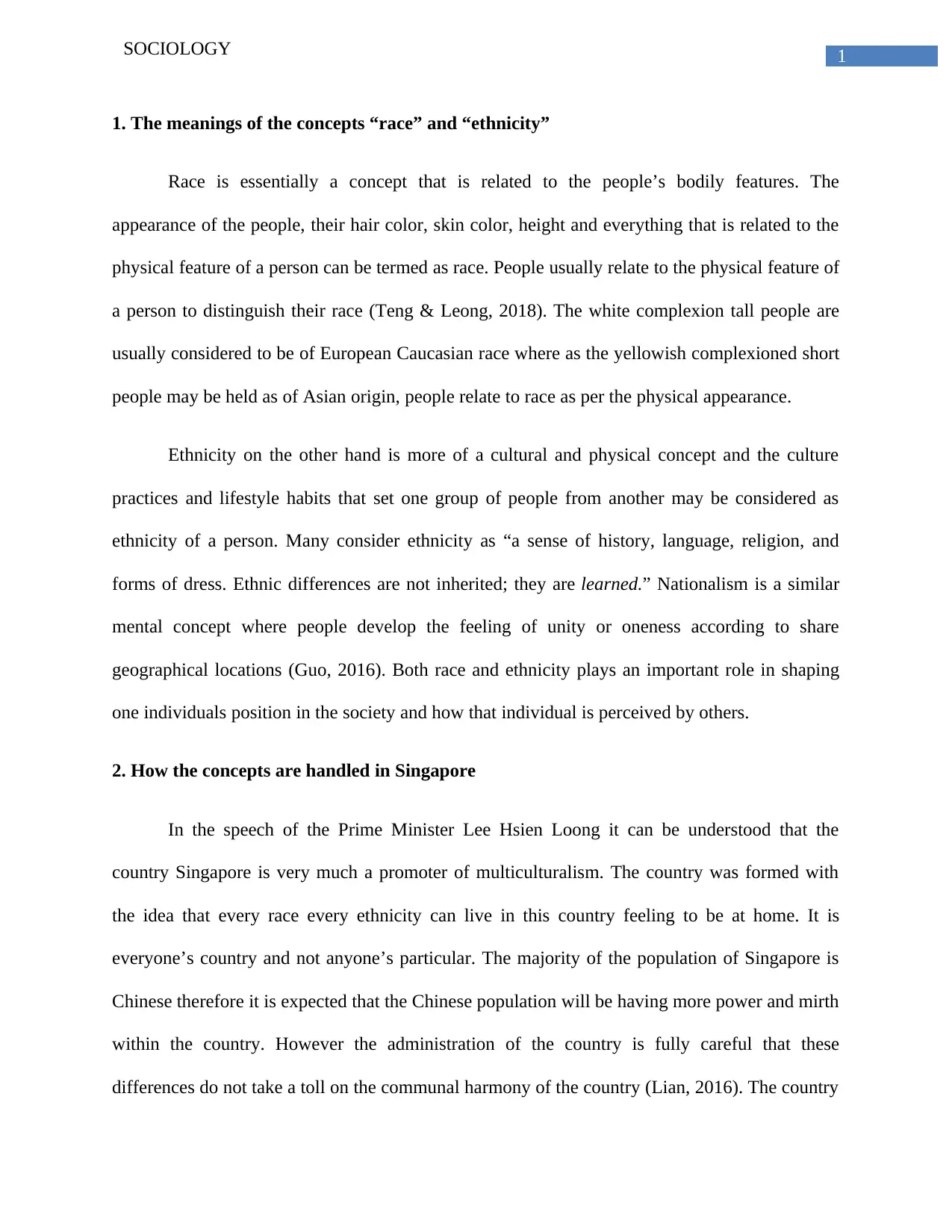
1SOCIOLOGY
1. The meanings of the concepts “race” and “ethnicity”
Race is essentially a concept that is related to the people’s bodily features. The
appearance of the people, their hair color, skin color, height and everything that is related to the
physical feature of a person can be termed as race. People usually relate to the physical feature of
a person to distinguish their race (Teng & Leong, 2018). The white complexion tall people are
usually considered to be of European Caucasian race where as the yellowish complexioned short
people may be held as of Asian origin, people relate to race as per the physical appearance.
Ethnicity on the other hand is more of a cultural and physical concept and the culture
practices and lifestyle habits that set one group of people from another may be considered as
ethnicity of a person. Many consider ethnicity as “a sense of history, language, religion, and
forms of dress. Ethnic differences are not inherited; they are learned.” Nationalism is a similar
mental concept where people develop the feeling of unity or oneness according to share
geographical locations (Guo, 2016). Both race and ethnicity plays an important role in shaping
one individuals position in the society and how that individual is perceived by others.
2. How the concepts are handled in Singapore
In the speech of the Prime Minister Lee Hsien Loong it can be understood that the
country Singapore is very much a promoter of multiculturalism. The country was formed with
the idea that every race every ethnicity can live in this country feeling to be at home. It is
everyone’s country and not anyone’s particular. The majority of the population of Singapore is
Chinese therefore it is expected that the Chinese population will be having more power and mirth
within the country. However the administration of the country is fully careful that these
differences do not take a toll on the communal harmony of the country (Lian, 2016). The country
1. The meanings of the concepts “race” and “ethnicity”
Race is essentially a concept that is related to the people’s bodily features. The
appearance of the people, their hair color, skin color, height and everything that is related to the
physical feature of a person can be termed as race. People usually relate to the physical feature of
a person to distinguish their race (Teng & Leong, 2018). The white complexion tall people are
usually considered to be of European Caucasian race where as the yellowish complexioned short
people may be held as of Asian origin, people relate to race as per the physical appearance.
Ethnicity on the other hand is more of a cultural and physical concept and the culture
practices and lifestyle habits that set one group of people from another may be considered as
ethnicity of a person. Many consider ethnicity as “a sense of history, language, religion, and
forms of dress. Ethnic differences are not inherited; they are learned.” Nationalism is a similar
mental concept where people develop the feeling of unity or oneness according to share
geographical locations (Guo, 2016). Both race and ethnicity plays an important role in shaping
one individuals position in the society and how that individual is perceived by others.
2. How the concepts are handled in Singapore
In the speech of the Prime Minister Lee Hsien Loong it can be understood that the
country Singapore is very much a promoter of multiculturalism. The country was formed with
the idea that every race every ethnicity can live in this country feeling to be at home. It is
everyone’s country and not anyone’s particular. The majority of the population of Singapore is
Chinese therefore it is expected that the Chinese population will be having more power and mirth
within the country. However the administration of the country is fully careful that these
differences do not take a toll on the communal harmony of the country (Lian, 2016). The country
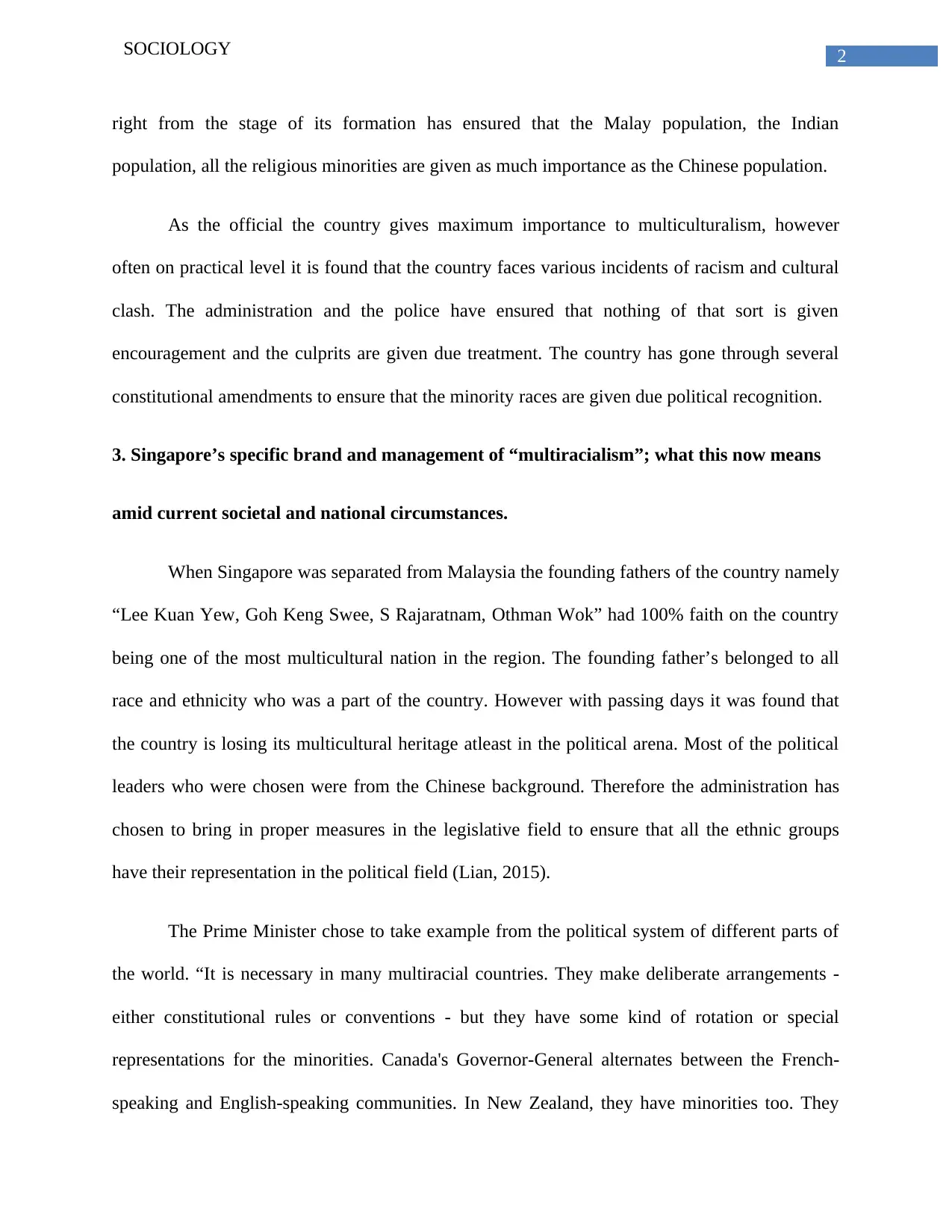
2SOCIOLOGY
right from the stage of its formation has ensured that the Malay population, the Indian
population, all the religious minorities are given as much importance as the Chinese population.
As the official the country gives maximum importance to multiculturalism, however
often on practical level it is found that the country faces various incidents of racism and cultural
clash. The administration and the police have ensured that nothing of that sort is given
encouragement and the culprits are given due treatment. The country has gone through several
constitutional amendments to ensure that the minority races are given due political recognition.
3. Singapore’s specific brand and management of “multiracialism”; what this now means
amid current societal and national circumstances.
When Singapore was separated from Malaysia the founding fathers of the country namely
“Lee Kuan Yew, Goh Keng Swee, S Rajaratnam, Othman Wok” had 100% faith on the country
being one of the most multicultural nation in the region. The founding father’s belonged to all
race and ethnicity who was a part of the country. However with passing days it was found that
the country is losing its multicultural heritage atleast in the political arena. Most of the political
leaders who were chosen were from the Chinese background. Therefore the administration has
chosen to bring in proper measures in the legislative field to ensure that all the ethnic groups
have their representation in the political field (Lian, 2015).
The Prime Minister chose to take example from the political system of different parts of
the world. “It is necessary in many multiracial countries. They make deliberate arrangements -
either constitutional rules or conventions - but they have some kind of rotation or special
representations for the minorities. Canada's Governor-General alternates between the French-
speaking and English-speaking communities. In New Zealand, they have minorities too. They
right from the stage of its formation has ensured that the Malay population, the Indian
population, all the religious minorities are given as much importance as the Chinese population.
As the official the country gives maximum importance to multiculturalism, however
often on practical level it is found that the country faces various incidents of racism and cultural
clash. The administration and the police have ensured that nothing of that sort is given
encouragement and the culprits are given due treatment. The country has gone through several
constitutional amendments to ensure that the minority races are given due political recognition.
3. Singapore’s specific brand and management of “multiracialism”; what this now means
amid current societal and national circumstances.
When Singapore was separated from Malaysia the founding fathers of the country namely
“Lee Kuan Yew, Goh Keng Swee, S Rajaratnam, Othman Wok” had 100% faith on the country
being one of the most multicultural nation in the region. The founding father’s belonged to all
race and ethnicity who was a part of the country. However with passing days it was found that
the country is losing its multicultural heritage atleast in the political arena. Most of the political
leaders who were chosen were from the Chinese background. Therefore the administration has
chosen to bring in proper measures in the legislative field to ensure that all the ethnic groups
have their representation in the political field (Lian, 2015).
The Prime Minister chose to take example from the political system of different parts of
the world. “It is necessary in many multiracial countries. They make deliberate arrangements -
either constitutional rules or conventions - but they have some kind of rotation or special
representations for the minorities. Canada's Governor-General alternates between the French-
speaking and English-speaking communities. In New Zealand, they have minorities too. They
⊘ This is a preview!⊘
Do you want full access?
Subscribe today to unlock all pages.

Trusted by 1+ million students worldwide
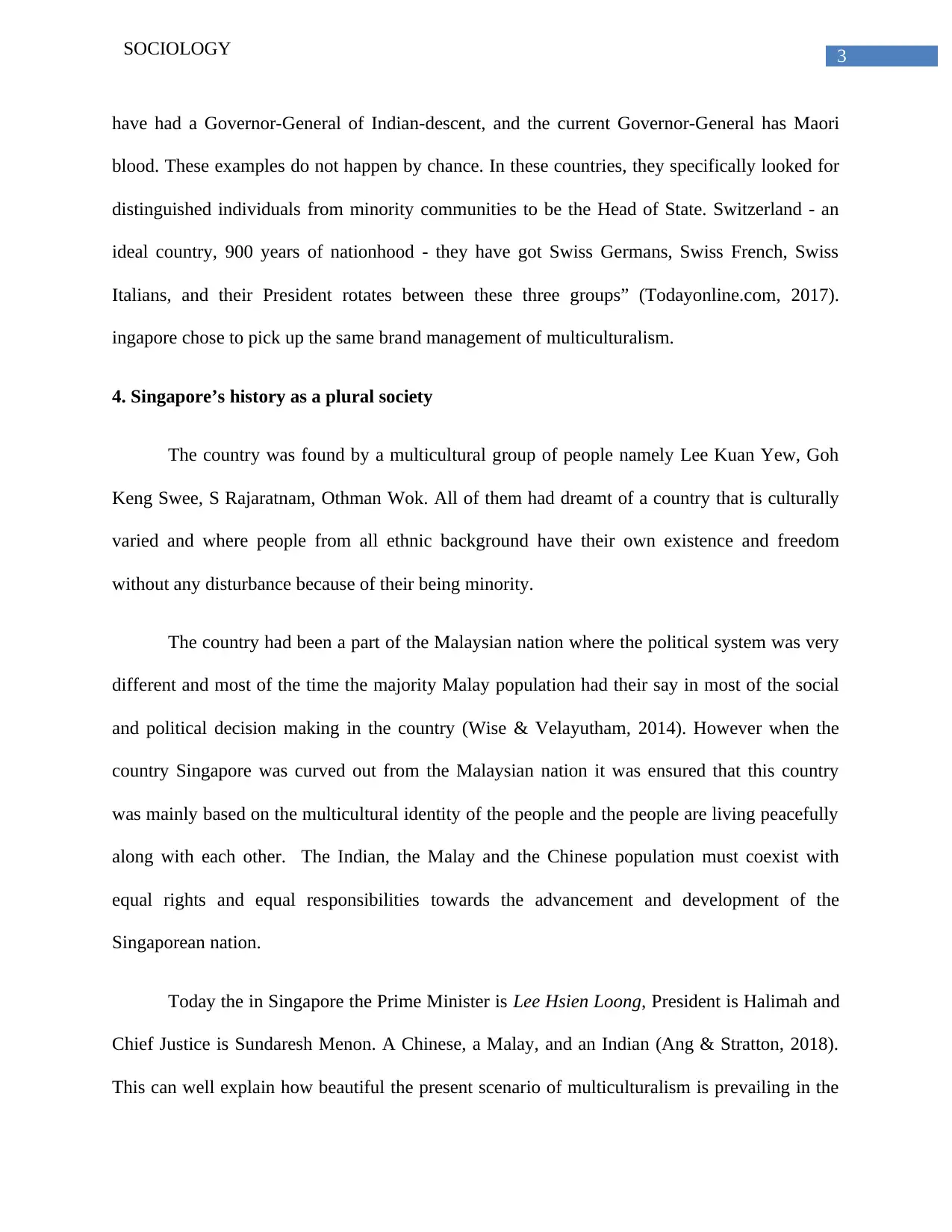
3SOCIOLOGY
have had a Governor-General of Indian-descent, and the current Governor-General has Maori
blood. These examples do not happen by chance. In these countries, they specifically looked for
distinguished individuals from minority communities to be the Head of State. Switzerland - an
ideal country, 900 years of nationhood - they have got Swiss Germans, Swiss French, Swiss
Italians, and their President rotates between these three groups” (Todayonline.com, 2017).
ingapore chose to pick up the same brand management of multiculturalism.
4. Singapore’s history as a plural society
The country was found by a multicultural group of people namely Lee Kuan Yew, Goh
Keng Swee, S Rajaratnam, Othman Wok. All of them had dreamt of a country that is culturally
varied and where people from all ethnic background have their own existence and freedom
without any disturbance because of their being minority.
The country had been a part of the Malaysian nation where the political system was very
different and most of the time the majority Malay population had their say in most of the social
and political decision making in the country (Wise & Velayutham, 2014). However when the
country Singapore was curved out from the Malaysian nation it was ensured that this country
was mainly based on the multicultural identity of the people and the people are living peacefully
along with each other. The Indian, the Malay and the Chinese population must coexist with
equal rights and equal responsibilities towards the advancement and development of the
Singaporean nation.
Today the in Singapore the Prime Minister is Lee Hsien Loong, President is Halimah and
Chief Justice is Sundaresh Menon. A Chinese, a Malay, and an Indian (Ang & Stratton, 2018).
This can well explain how beautiful the present scenario of multiculturalism is prevailing in the
have had a Governor-General of Indian-descent, and the current Governor-General has Maori
blood. These examples do not happen by chance. In these countries, they specifically looked for
distinguished individuals from minority communities to be the Head of State. Switzerland - an
ideal country, 900 years of nationhood - they have got Swiss Germans, Swiss French, Swiss
Italians, and their President rotates between these three groups” (Todayonline.com, 2017).
ingapore chose to pick up the same brand management of multiculturalism.
4. Singapore’s history as a plural society
The country was found by a multicultural group of people namely Lee Kuan Yew, Goh
Keng Swee, S Rajaratnam, Othman Wok. All of them had dreamt of a country that is culturally
varied and where people from all ethnic background have their own existence and freedom
without any disturbance because of their being minority.
The country had been a part of the Malaysian nation where the political system was very
different and most of the time the majority Malay population had their say in most of the social
and political decision making in the country (Wise & Velayutham, 2014). However when the
country Singapore was curved out from the Malaysian nation it was ensured that this country
was mainly based on the multicultural identity of the people and the people are living peacefully
along with each other. The Indian, the Malay and the Chinese population must coexist with
equal rights and equal responsibilities towards the advancement and development of the
Singaporean nation.
Today the in Singapore the Prime Minister is Lee Hsien Loong, President is Halimah and
Chief Justice is Sundaresh Menon. A Chinese, a Malay, and an Indian (Ang & Stratton, 2018).
This can well explain how beautiful the present scenario of multiculturalism is prevailing in the
Paraphrase This Document
Need a fresh take? Get an instant paraphrase of this document with our AI Paraphraser
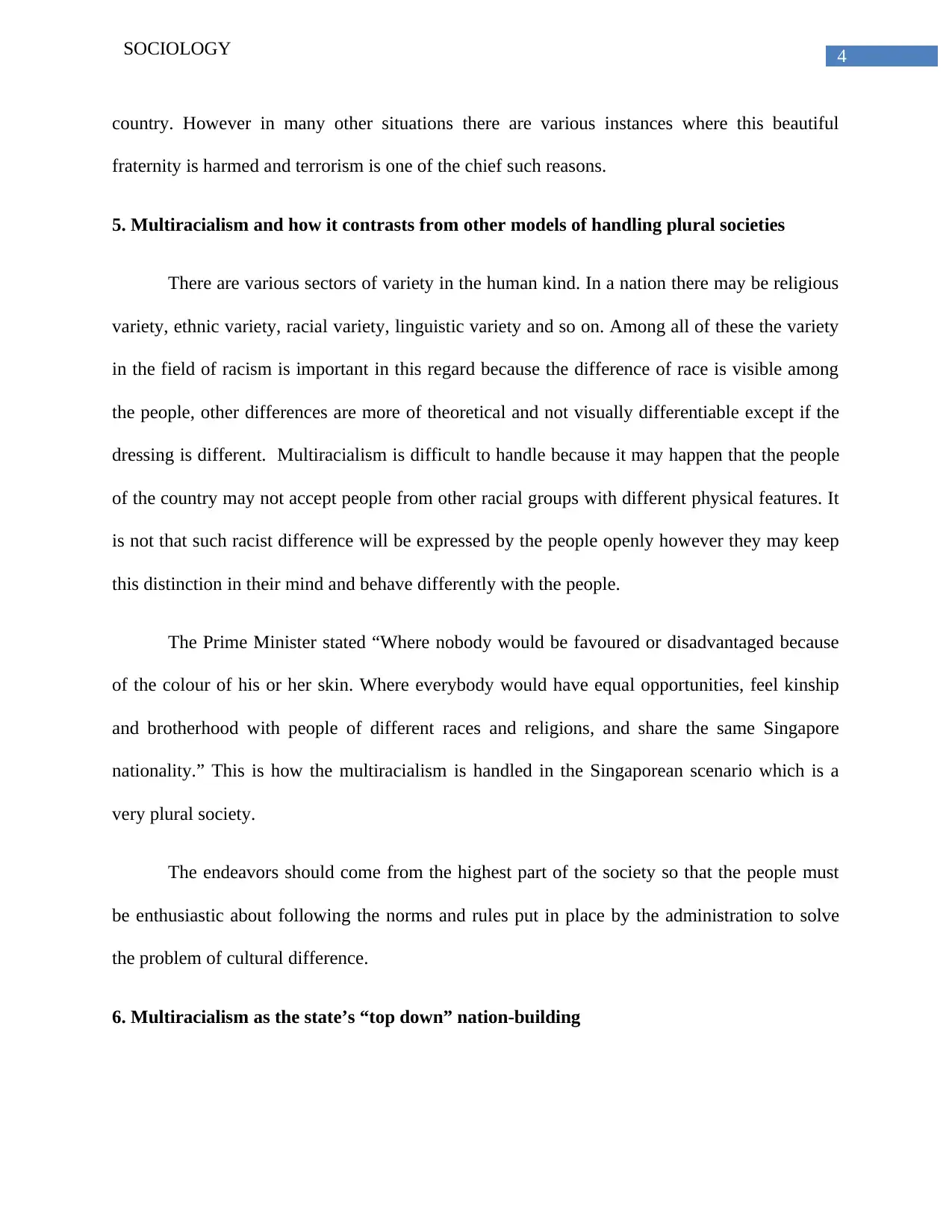
4SOCIOLOGY
country. However in many other situations there are various instances where this beautiful
fraternity is harmed and terrorism is one of the chief such reasons.
5. Multiracialism and how it contrasts from other models of handling plural societies
There are various sectors of variety in the human kind. In a nation there may be religious
variety, ethnic variety, racial variety, linguistic variety and so on. Among all of these the variety
in the field of racism is important in this regard because the difference of race is visible among
the people, other differences are more of theoretical and not visually differentiable except if the
dressing is different. Multiracialism is difficult to handle because it may happen that the people
of the country may not accept people from other racial groups with different physical features. It
is not that such racist difference will be expressed by the people openly however they may keep
this distinction in their mind and behave differently with the people.
The Prime Minister stated “Where nobody would be favoured or disadvantaged because
of the colour of his or her skin. Where everybody would have equal opportunities, feel kinship
and brotherhood with people of different races and religions, and share the same Singapore
nationality.” This is how the multiracialism is handled in the Singaporean scenario which is a
very plural society.
The endeavors should come from the highest part of the society so that the people must
be enthusiastic about following the norms and rules put in place by the administration to solve
the problem of cultural difference.
6. Multiracialism as the state’s “top down” nation-building
country. However in many other situations there are various instances where this beautiful
fraternity is harmed and terrorism is one of the chief such reasons.
5. Multiracialism and how it contrasts from other models of handling plural societies
There are various sectors of variety in the human kind. In a nation there may be religious
variety, ethnic variety, racial variety, linguistic variety and so on. Among all of these the variety
in the field of racism is important in this regard because the difference of race is visible among
the people, other differences are more of theoretical and not visually differentiable except if the
dressing is different. Multiracialism is difficult to handle because it may happen that the people
of the country may not accept people from other racial groups with different physical features. It
is not that such racist difference will be expressed by the people openly however they may keep
this distinction in their mind and behave differently with the people.
The Prime Minister stated “Where nobody would be favoured or disadvantaged because
of the colour of his or her skin. Where everybody would have equal opportunities, feel kinship
and brotherhood with people of different races and religions, and share the same Singapore
nationality.” This is how the multiracialism is handled in the Singaporean scenario which is a
very plural society.
The endeavors should come from the highest part of the society so that the people must
be enthusiastic about following the norms and rules put in place by the administration to solve
the problem of cultural difference.
6. Multiracialism as the state’s “top down” nation-building
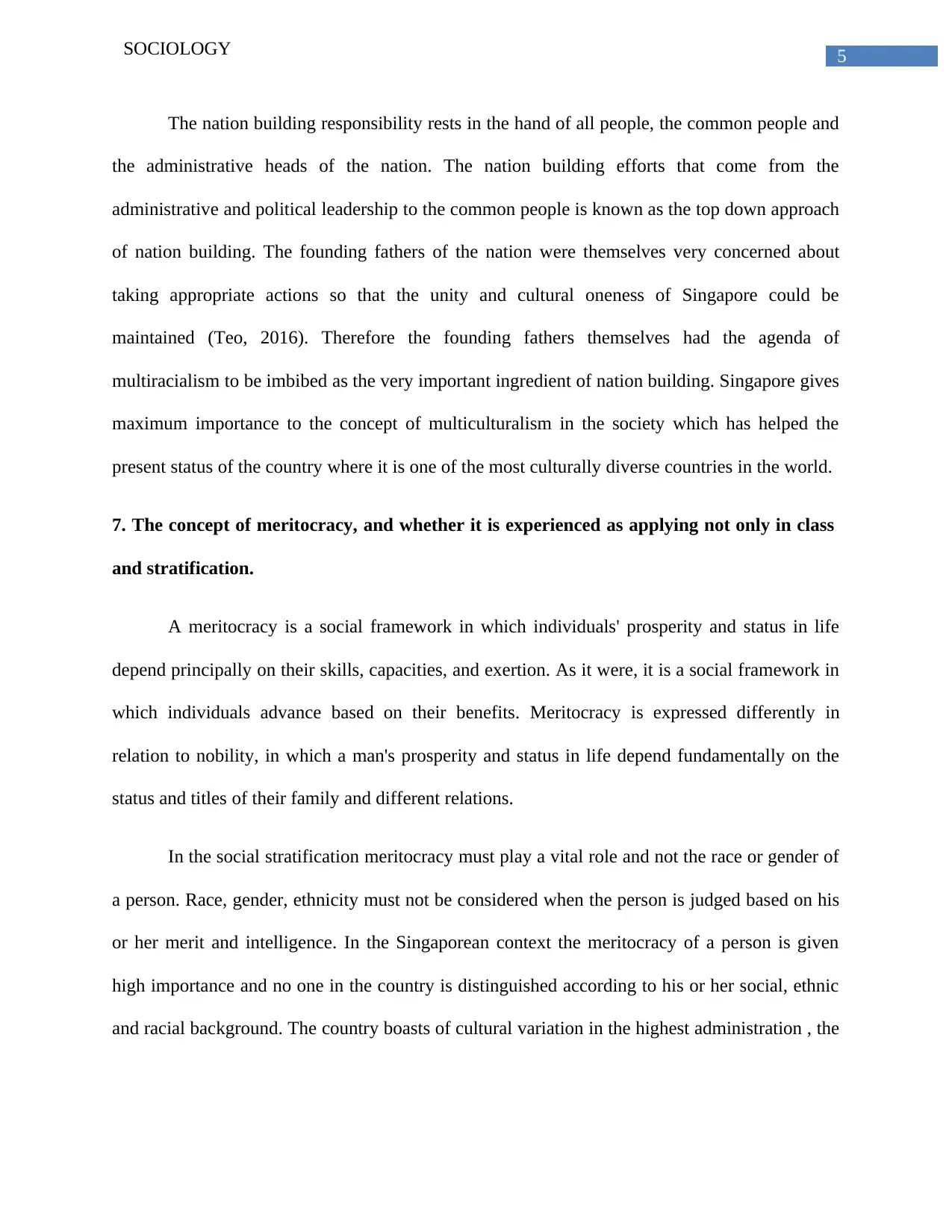
5SOCIOLOGY
The nation building responsibility rests in the hand of all people, the common people and
the administrative heads of the nation. The nation building efforts that come from the
administrative and political leadership to the common people is known as the top down approach
of nation building. The founding fathers of the nation were themselves very concerned about
taking appropriate actions so that the unity and cultural oneness of Singapore could be
maintained (Teo, 2016). Therefore the founding fathers themselves had the agenda of
multiracialism to be imbibed as the very important ingredient of nation building. Singapore gives
maximum importance to the concept of multiculturalism in the society which has helped the
present status of the country where it is one of the most culturally diverse countries in the world.
7. The concept of meritocracy, and whether it is experienced as applying not only in class
and stratification.
A meritocracy is a social framework in which individuals' prosperity and status in life
depend principally on their skills, capacities, and exertion. As it were, it is a social framework in
which individuals advance based on their benefits. Meritocracy is expressed differently in
relation to nobility, in which a man's prosperity and status in life depend fundamentally on the
status and titles of their family and different relations.
In the social stratification meritocracy must play a vital role and not the race or gender of
a person. Race, gender, ethnicity must not be considered when the person is judged based on his
or her merit and intelligence. In the Singaporean context the meritocracy of a person is given
high importance and no one in the country is distinguished according to his or her social, ethnic
and racial background. The country boasts of cultural variation in the highest administration , the
The nation building responsibility rests in the hand of all people, the common people and
the administrative heads of the nation. The nation building efforts that come from the
administrative and political leadership to the common people is known as the top down approach
of nation building. The founding fathers of the nation were themselves very concerned about
taking appropriate actions so that the unity and cultural oneness of Singapore could be
maintained (Teo, 2016). Therefore the founding fathers themselves had the agenda of
multiracialism to be imbibed as the very important ingredient of nation building. Singapore gives
maximum importance to the concept of multiculturalism in the society which has helped the
present status of the country where it is one of the most culturally diverse countries in the world.
7. The concept of meritocracy, and whether it is experienced as applying not only in class
and stratification.
A meritocracy is a social framework in which individuals' prosperity and status in life
depend principally on their skills, capacities, and exertion. As it were, it is a social framework in
which individuals advance based on their benefits. Meritocracy is expressed differently in
relation to nobility, in which a man's prosperity and status in life depend fundamentally on the
status and titles of their family and different relations.
In the social stratification meritocracy must play a vital role and not the race or gender of
a person. Race, gender, ethnicity must not be considered when the person is judged based on his
or her merit and intelligence. In the Singaporean context the meritocracy of a person is given
high importance and no one in the country is distinguished according to his or her social, ethnic
and racial background. The country boasts of cultural variation in the highest administration , the
⊘ This is a preview!⊘
Do you want full access?
Subscribe today to unlock all pages.

Trusted by 1+ million students worldwide
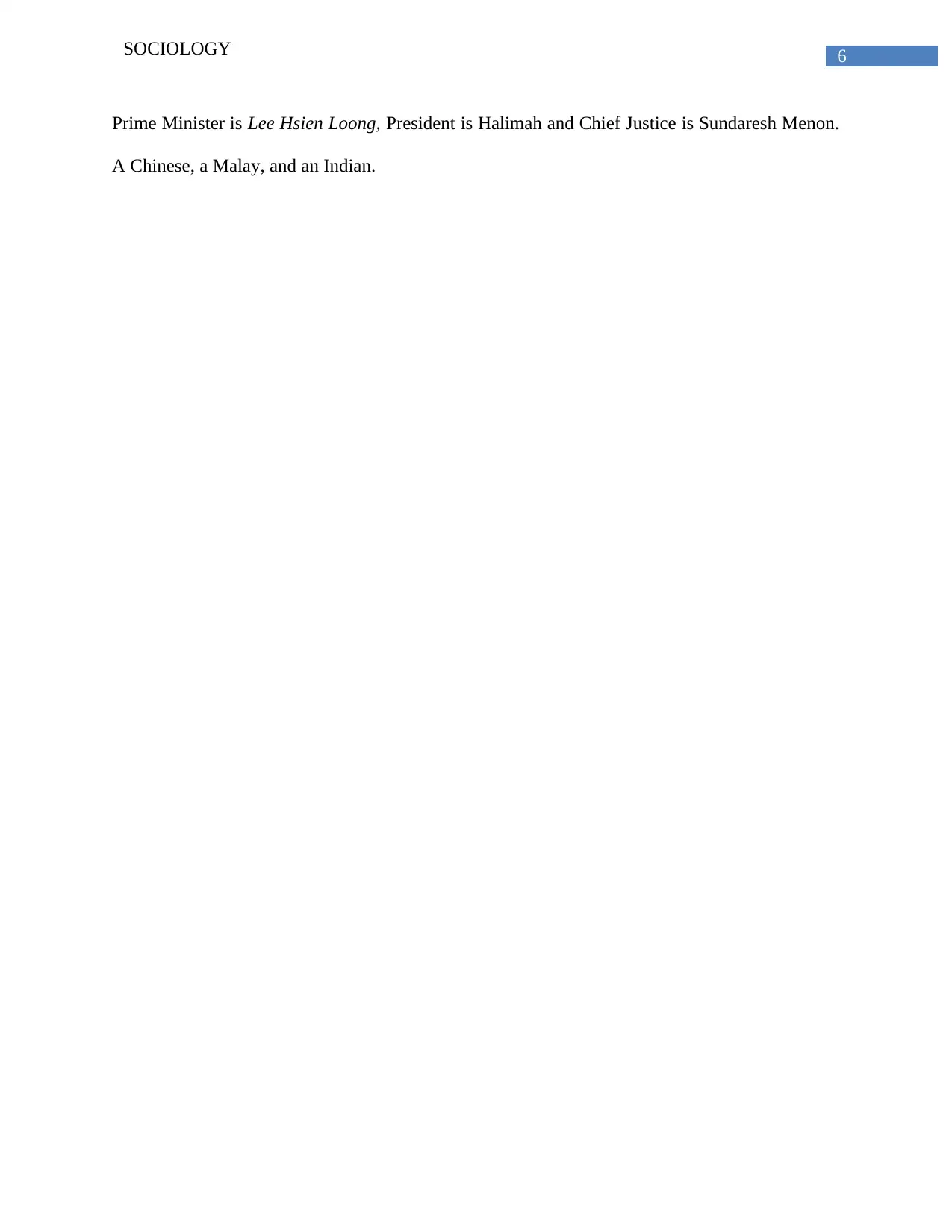
6SOCIOLOGY
Prime Minister is Lee Hsien Loong, President is Halimah and Chief Justice is Sundaresh Menon.
A Chinese, a Malay, and an Indian.
Prime Minister is Lee Hsien Loong, President is Halimah and Chief Justice is Sundaresh Menon.
A Chinese, a Malay, and an Indian.
Paraphrase This Document
Need a fresh take? Get an instant paraphrase of this document with our AI Paraphraser
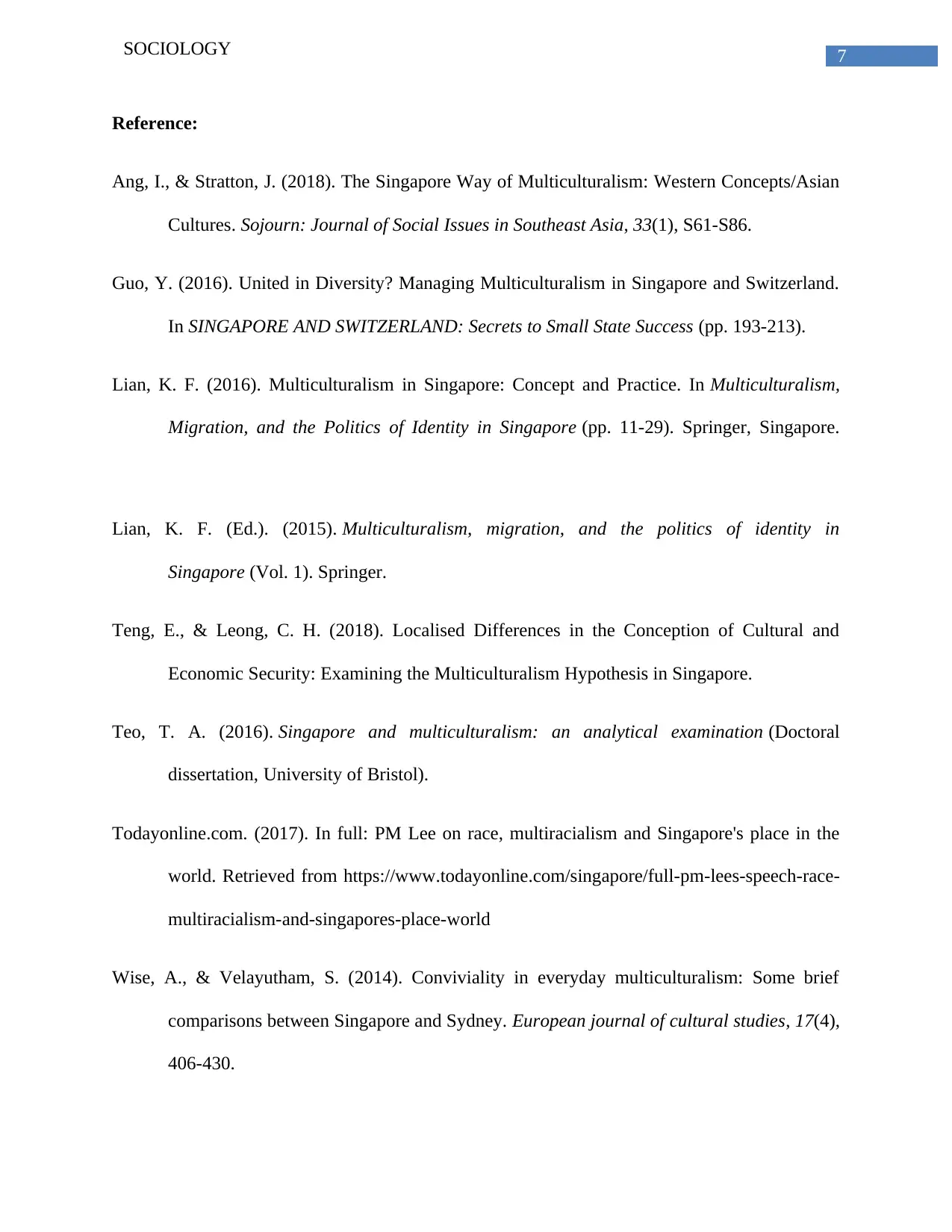
7SOCIOLOGY
Reference:
Ang, I., & Stratton, J. (2018). The Singapore Way of Multiculturalism: Western Concepts/Asian
Cultures. Sojourn: Journal of Social Issues in Southeast Asia, 33(1), S61-S86.
Guo, Y. (2016). United in Diversity? Managing Multiculturalism in Singapore and Switzerland.
In SINGAPORE AND SWITZERLAND: Secrets to Small State Success (pp. 193-213).
Lian, K. F. (2016). Multiculturalism in Singapore: Concept and Practice. In Multiculturalism,
Migration, and the Politics of Identity in Singapore (pp. 11-29). Springer, Singapore.
Lian, K. F. (Ed.). (2015). Multiculturalism, migration, and the politics of identity in
Singapore (Vol. 1). Springer.
Teng, E., & Leong, C. H. (2018). Localised Differences in the Conception of Cultural and
Economic Security: Examining the Multiculturalism Hypothesis in Singapore.
Teo, T. A. (2016). Singapore and multiculturalism: an analytical examination (Doctoral
dissertation, University of Bristol).
Todayonline.com. (2017). In full: PM Lee on race, multiracialism and Singapore's place in the
world. Retrieved from https://www.todayonline.com/singapore/full-pm-lees-speech-race-
multiracialism-and-singapores-place-world
Wise, A., & Velayutham, S. (2014). Conviviality in everyday multiculturalism: Some brief
comparisons between Singapore and Sydney. European journal of cultural studies, 17(4),
406-430.
Reference:
Ang, I., & Stratton, J. (2018). The Singapore Way of Multiculturalism: Western Concepts/Asian
Cultures. Sojourn: Journal of Social Issues in Southeast Asia, 33(1), S61-S86.
Guo, Y. (2016). United in Diversity? Managing Multiculturalism in Singapore and Switzerland.
In SINGAPORE AND SWITZERLAND: Secrets to Small State Success (pp. 193-213).
Lian, K. F. (2016). Multiculturalism in Singapore: Concept and Practice. In Multiculturalism,
Migration, and the Politics of Identity in Singapore (pp. 11-29). Springer, Singapore.
Lian, K. F. (Ed.). (2015). Multiculturalism, migration, and the politics of identity in
Singapore (Vol. 1). Springer.
Teng, E., & Leong, C. H. (2018). Localised Differences in the Conception of Cultural and
Economic Security: Examining the Multiculturalism Hypothesis in Singapore.
Teo, T. A. (2016). Singapore and multiculturalism: an analytical examination (Doctoral
dissertation, University of Bristol).
Todayonline.com. (2017). In full: PM Lee on race, multiracialism and Singapore's place in the
world. Retrieved from https://www.todayonline.com/singapore/full-pm-lees-speech-race-
multiracialism-and-singapores-place-world
Wise, A., & Velayutham, S. (2014). Conviviality in everyday multiculturalism: Some brief
comparisons between Singapore and Sydney. European journal of cultural studies, 17(4),
406-430.

8SOCIOLOGY
⊘ This is a preview!⊘
Do you want full access?
Subscribe today to unlock all pages.

Trusted by 1+ million students worldwide
1 out of 9
Related Documents
Your All-in-One AI-Powered Toolkit for Academic Success.
+13062052269
info@desklib.com
Available 24*7 on WhatsApp / Email
![[object Object]](/_next/static/media/star-bottom.7253800d.svg)
Unlock your academic potential
Copyright © 2020–2025 A2Z Services. All Rights Reserved. Developed and managed by ZUCOL.





